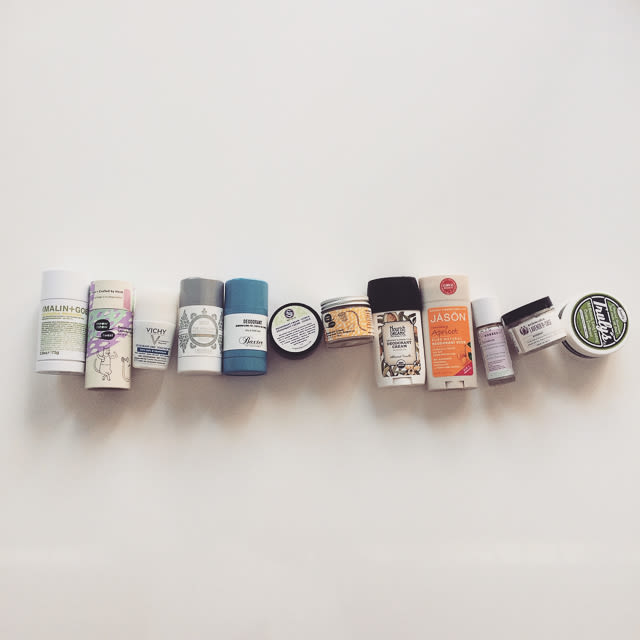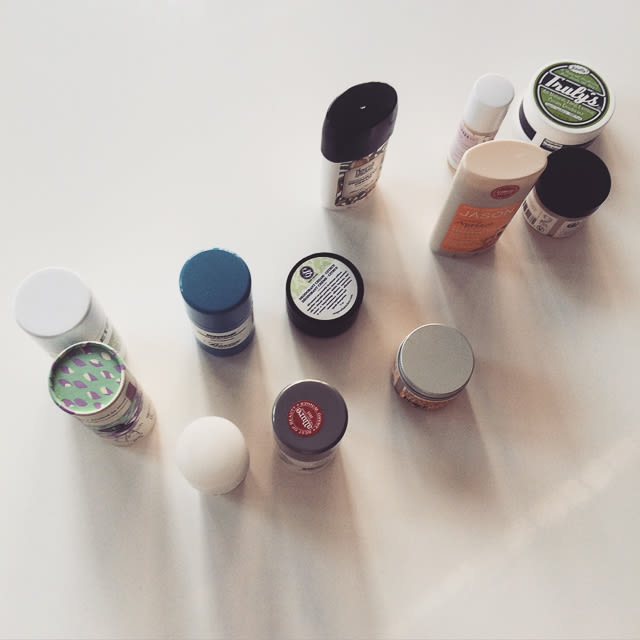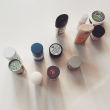Melissa Souto has a really fun job. Here at Glossier, she's the Product Marketing and Development Manager, which means her desk is always covered with bins and bins of the best beauty products for personal and professional trial and error. One thing we noticed her trying a lot of recently was natural deodorant. Now, good natural deodorant seems like a myth to many, but if anybody was going to find the truth once and for all, it would be Melissa. So we made her keep a diary during her trials so when she was done, we could publish it for all to see. The day has arrived. Without further ado, Melissa's Deodorant Diary:
On my first day at Glossier, I noticed one very strange and very specific thing about nearly everyone who works here: They're obsessed with talking about deodorant. Particularly debating the pros and cons of switching from antiperspirant to natural formulas. Now, I've spent the majority of my adult life working in beauty (and the majority of the rest of my life using deodorant) and I still couldn't hold a candle to the number of sticks, pastes, and crystals people at Glossier HQ have roadtested. As a product marketer and developer, I began feeling guilty that I was very unaware and uneducated on the topic. So, I quietly set off on my own private testing.
Why was I doing this? For me, it was to get a sense of the market. But for many people it hinges on ingredients. Antiperspirant’s classification as a carcinogen is a rocky claim but it’s generally accepted as fact amongst anti-antiperspirant users. For years now, there have been concerns about the negative side effects of aluminium, the active ingredient that essentially plugs your sweat ducts and stops sweat from flowing. Sounds pretty awesome if you’re a naturally sweaty person (like me). However, reports suggest that because antiperspirants are applied frequently and on skin near your breasts, it may be absorbed and cause estrogen-like hormonal effects and contribute to the development of breast cancer.
Let me say that these reports have never been corroborated. In fact, the National Cancer Institute, National Institutes of Health, and the U.S. Food and Drug Administration all confirm that they do not have any conclusive evidence that ingredients in antiperspirants cause cancer. But the more I thought about it, there was still something a little frightening to me about the idea that you’re physically preventing a natural bodily function from occurring. Speculation or truth, I decided to err on the side of caution and make the switch.
Once you decide antiperspirants are no longer for you, be prepared to endure the subsequent detox period that follows. Heck, Milk and Malin+Goetz even warn you about it on their websites. What they might not explicitly state though is that one of the side effects might include a period of extra smelliness. This, I was forewarned about from my boss, Pauline Maynard, who had recently gone through it herself. She explained to me that when you take the leap from antiperspirant to deodorant, your sweat glands overcompensate from being plugged up for so long and start over-producing sweat and you begin smelling like...well, for lack of a better comparison, like a caveman.
In terms of which deos to try first, I turned to the office Slack. Beyond any potential health benefits, many called out how antiperspirants stained their clothing (“I’d always choose smelling over staining a shirt” - Eva Alt, Social Media Editor). And it’s true; the aluminium in antiperspirant is why your shirts’ pits are yellowing, not sweat, contrary to popular belief.
Many popular natural deodorant candidates were deemed unworthy by the group and will remain unnamed. (We're a classy joint here at ITG.) They were nixed for various reasons, including extreme staining (usually because of high levels of coconut oil), extreme ineffectiveness, or extreme drying out of the stick (making it hard and unpleasant to apply). Those left standing where as follows:
- Baxter
- Agent Nateur
- Meow Meow Tweet in stick form
- Lavanila Sport Luxe
Piperwai and Soapwalla will get honorable mentions from the group, but I didn't test them because I'm not about the scoop life.
To truly test each, I kept a diary each day of feels, smells, and shirt staining. I now publish it for your use. Let the detox begin:
Day 1: First up was Meow Meow Tweet in Lavender Bergamot. It’s not too hot out today. As I’m on the subway though, I begin thinking about just how breathable my shirt really is. A silk blouse was probably not the best idea. I definitely can’t get away with skipping the dry cleaners this week. Around midday I start recalling some previous reading on citrus scents and their propensity to smell like cat pee. Noted. Duly noted.
Day 2: Still going with Meow Meow Tweet. I went to reach for a can of Coke and was compelled to ask our Director of Supply Chain to smell my pits. Later that night, I met a college friend who was in town for dinner. I considered canceling because I didn’t want her to remember me like this. Memories are tied to scent, as we know.
Day 3: I don’t know what it is about this Lavender Bergamot but I smell straight up like an illegal (albeit natural) substance.
Day 4: I continue to smell a bit earthy. However, sweat is being absorbed better than I expected. In any case, time to switch Baxter.
Day 5-6: Flying out to Los Angeles for a business trip where it is a high of 93 degrees. I woke up and promptly applied Baxter. By midday, I smell worse than I have ever remembered myself smelling. The formula seems to just play up my body’s odor tendencies and the citrus and herbal-musk scent does nothing to cover it up. I should’ve known since “musky” is not what I strive to smell like in the armpit region. Also, my left armpit smells terrible while my right is fresh as a daisy. This seems to be a trend throughout the entirety of the transition period but was particularly bad during Baxter. Who knew your armpits were like your eyebrows—one is always better than the other?
Day 7: Back in New York and happy to have deodorant options again. I decide to reach for Agent Nateur. It has a coconut oil base (naturally antibacterial) which gives me a “gliding” feeling under my armpits. Unfortunately, that heavy-duty moisturizing effect makes me feel like I’m sweating even more than I already am.
Day 8: First workout while using deodorant (yes, I hadn’t worked out in eight days and I’m not proud of it). I sweat more than usual and end up feeling as if I have an ecosystem forming under there.
Day 9: First turtleneck of the season. Feeling good on my walk to the subway. But once I’m on, all hell breaks loose. I feel a tickle down my left side. I realize that tickle is a lone sweat droplet. I bow my head in shame for the rest of the ride.
Day 9 Update: Good news is the eucalyptus and lavender oils are working well to keep any smells under wraps.
Day 10: I emerge from the shower and go to apply Agent Nateur. I notice that my armpit has turned a lovely fall shade of reddish-brown. After extensive research, I find out I have an alkaline burn most likely caused by the high level of baking soda in this formula (it’s the second ingredient on the list after coconut oil).
Day 10-14: As a result of the burn, my skin begins to flake off. I turn to a more gentle Vichy roll-on deodorant for some relief. Although not 100% natural, its liquidy consistency feels cooling and less harsh to apply. But it’s a double-edged sword; I also find the roll-on application impossible to evenly dispense the product. Also, at first I appreciated the light, fresh scent, but came to resent it when it provided ineffective at covering up odor.
Day 15 - today: Lavanila Sport Luxe is my last chance. As opposed to Meow Meow Tweet and Agent Nateur which both have coconut oil bases, Lavanila has a propanediol, sodium stearate and glycerin base (think less oily, more creamy solid). The smell (which is called Vanilla Breeze and smells anything but) reminds me of the fresh, vaguely European pharmacy products my Spanish grandmothers use, in a good way. I preferred the texture of this natural deodorant out of all the contenders. It most resembled the traditional, mass antiperspirant deodorants I was used to—just like my old old faithful Dove Go Fresh Cool Essentials Cucumber and Green Tea Scent. Even though the odor protection waned since I began, I appreciate the psychological comfort and nostalgia it imparts, which is probably why I’ve continued to use it.
The Verdict: Throughout my detox, several things became clear to me about choosing what deodorant works best.
-
Texture. Whether it’s an anhydrous oil base, a scoopable cream, a cream stick or a liquid roll-on, the application method is a huge part of the experience.
-
Scent. We’ve all been that person in the deodorant aisle of CVS smelling every option before deciding you want to be a “shower fresh” or a “oh-la-la lavender”. However, with all deodorants (but especially natural deodorants), it is equally as important to see how that scent interacts with your body over a couple of uses. A scent I may have initially loved could have not interacted well with my natural body odor (see: cat pee). Finally, and most importantly...
-
Your natural body odor will always peek out—it just depends on to what degree. I’ve come to accept nothing (at least nothing natural or naturally-derived) will completely stop it. Will I ever really get over my coworkers catching me tucking my nose into my shirt to see how everything is going down there? Probably not. But a little stank here and there is OK with me for the potential health upsides. I smell more “human” and, in the end, I’m alright with that. Let’s just hope the guy standing next to me on the subway is, too.
—Melissa Souto
Photographed by the author.
Go native with ITG's favorite all-natural beauty products. Or at least help us decide what the best body lotion is?




